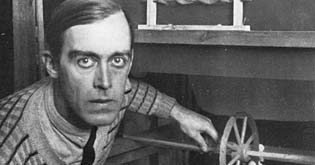Walter Ruttmann: Weekend (1930) 11'10"
 Weekend is a pioneering work from the early days of radio, commissioned in 1928 by Berlin Radio Hour. In a collage of words, music fragments and sounds, the film-maker and media artist Walter Ruttmann presented on 13 June 1930 a radically innovative radio piece: an acoustic picture of a Berlin weekend urban landscape.
Weekend is a pioneering work from the early days of radio, commissioned in 1928 by Berlin Radio Hour. In a collage of words, music fragments and sounds, the film-maker and media artist Walter Ruttmann presented on 13 June 1930 a radically innovative radio piece: an acoustic picture of a Berlin weekend urban landscape.
Although the term musique concrete was coined to describe Schaeffer's Etude composed in 1948 and the tape works by him and the dozens (and then hundreds) of others who would follow, it is no stretch really to take Weekend as the first concrete piece. Except perhaps for the quality of the recording, it certainly sounds as if it could have been written any time between 1948 and 1958.
Ruttmann did not discuss Weekend extensively, but he did write a brief description of the piece. He said, "Weekend is a study in sound-montage…. In Weekend sound was an end itself."
Before making Weekend, Ruttmann had produced the experimental documentary Berlin-Symphony of a Great City (1927) as well as a number of short, experimental abstract animations. After his experience with his films, Ruttmann deliberately sought possibilities for producing an audio-film for radio. "Everything audible in the world becomes material," he wrote in a manifesto in 1929, prefiguring Schaeffer, Varese, Cage and the other giants of the musical avant-garde.
Tones and sounds should exist in their own right. For Weekend they were recorded as arbitrary and intentional elements on the soundtrack of an optical sound film using the so-called Tri-Ergon process. For the first time an artistic radio production was created whose material could be assembled and designed according to rhythmic, musical principles.
The original of Weekend was long considered lost. A copy was only rediscovered in New York in 1978.
Walter Ruttmann (Frankfort, Germany 1887 - Berlin, Germany, 1941)
With a background as a painter, and cellist/violinist, Walter Ruttmann found his way to making experimental abstract animations in the 1920s, and later, feature length documentary films. Ruttmann was in a milieu of painters, poets and musicians who saw in the new media a possibility to expand the limits of the fine arts. They described their abstract films as visual music, seeking to achieve a similar experience in the visual as in music. The overall idea of their works was also linked to the concept of the absolute film; the idea of a universal language of abstract images.
Ruttmann's most well-known film is Berlin-Symphony of a Great City, which utilized the Kino-Eye or Cinematic-Eye technique of Dziga Vertov. This is documentary filmmaking at its most poetic and expressive. His later World Melodies expanded on the synthesis of the visual and the musical with scenes taken from all over the world.
During the late 1930s Ruttmann delved deeper into documentary filmmaking, which likely led to his work on various propaganda films. As Germany moved towards World War II, Ruttmann worked with Leni Riefenstahl in the writing of the famous Nazi propaganda film Triumph of the Will(1934), and later the editing of Olympia (1938). Whether or not Ruttmann would have suffered the same lapse in reputation that Riefenstahl did after the war will never be known, as he was killed on the war front making a newsreel just three short years later.
